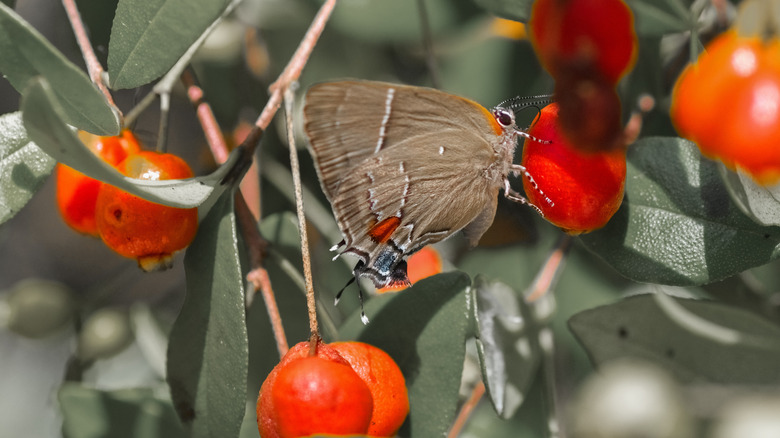Attract Cardinals And Pollinators To Your Yard With A Colorful Shrub They Love
Birdwatching is a fun hobby that doesn't require much to get started. A comfy patio chair and some patience are all you need to start admiring the birds and pollinators that stop by your garden. If you want to attract more butterflies, bees, and stunning red cardinals, you'll want to grow the Simpson's stopper (Myrcianthes fragrans), also known as a twinberry.
The Simpson's stopper is a great source of low-maintenance flowers that will draw plenty of pollinators and birds to your yard. Butterflies, bees, and other buzzing things will enjoy the countless flowers it produces. Once the flowers turn to berries, you'll spot cardinals and other birds snacking on them. It's a drought-tolerant evergreen plant that will allow you to keep wildlife in your yard all year long. As the seasons change, the Simpson's stopper will keep its leaves and become a safe place for birds and pollinators to spend the winter.
Birds and bees will stop for a Simpson's stopper
Cardinals are a little picky about where they build their nests. They like brushy areas that are well hidden so they can protect themselves and their eggs, which is why they typically live in low-lying shrubs and short trees. You can find them in hedges and shrubs in suburban areas because of the great cover they provide. Since cardinals don't like birdhouses, plant Simpson's stopper near other shrubs and trees to build up a woods-like area in your landscape so the birds can feel protected. The bearberry shrub (Arctostaphylos uva-ursi) is a good companion plant because it stays low to the ground and can tolerate some shade, so it would work well underneath the Simpson's stopper.
The Simpson's stopper produces an abundance of white flowers that are attractive to a variety of pollinators. You're sure to see bees and butterflies as well as other beneficial pollinators during the spring months and into summer. Allowing your shrub to keep its natural shape will ensure you have plenty of flowers for the pollinators. However, you can prune several plants to form a hedge to provide plenty of space for birds and pollinators. If you choose to prune your Simpson's stopper, avoid pruning the new growth since that's where flowers bloom. Keep the new bright green leaves and prune the old, darker leaves to maximize the number of flowers and berries that develop.
Using the Simpson's stopper strategically
Cardinals like to hunker down near water sources, so planting your shrubs near streams, ponds, or birdbaths is ideal. Though these birds don't like birdhouses, they do like to stop at feeders filled with nuts, mealworms, sunflower seeds, and corn. You can sprinkle seeds on the ground near the shrubs if you don't have a good place to hang a feeder. Planting other berry-producing shrubs like bearberry, beautyberry (Callicarpa americana), or holly (Ilex), will ensure there are plenty of flowers and berries to attract wildlife to your yard.
Consider the rest of your yard as you determine where to plant a Simpson's stopper. Planting along a fence or by a shed may help the birds feel more protected, but make sure the plant will receive enough sunlight. Since cardinals also like to eat various insects like caterpillars, planting the shrub near a flower bed or vegetable garden will help keep them fed. A variety of flowers will encourage pollinators to stop by the shrubs, which could in turn help feed the birds. Consider planting short drought-tolerant flowers like lantana (Lantana camara), vinca (Catharanthus roseus), or firecracker flowers (Crossanda infundibuliformis).


